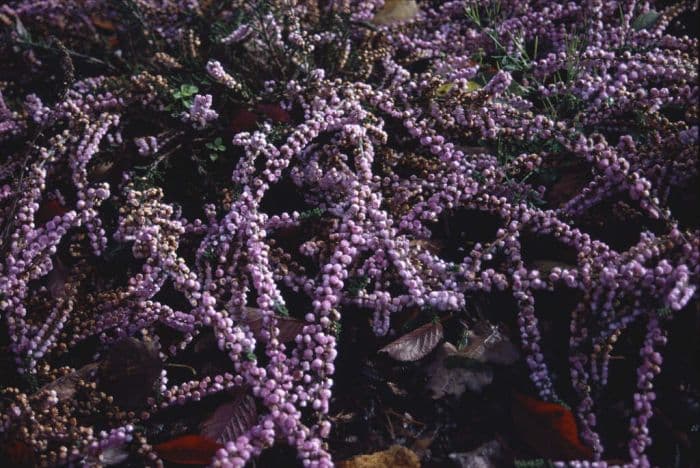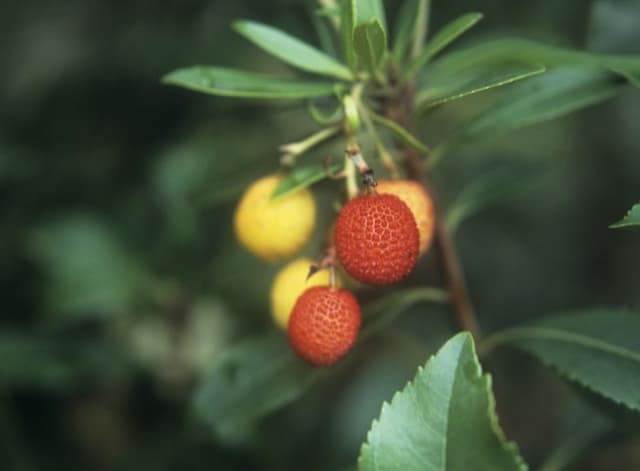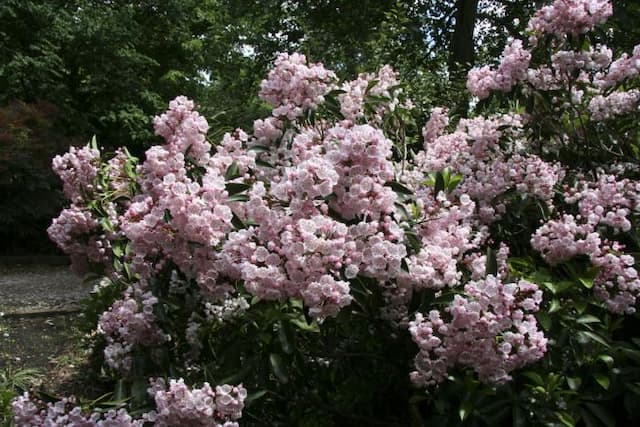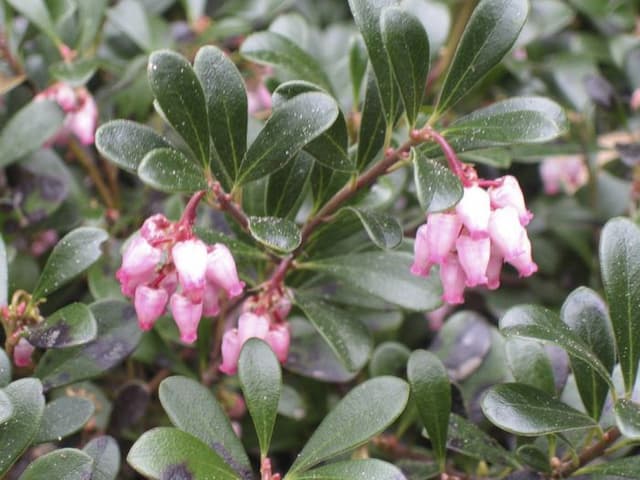Heather Calluna vulgaris 'Elsie Purnell' (d)

ABOUT
'Elsie Purnell' is a variety of Heather that is particularly appreciated for its decorative appeal. This plant showcases small, scale-like evergreen leaves that densely cover the stems, creating a fine, textured appearance. During the bloom period, it becomes even more striking as it produces clusters of small, bell-shaped flowers that are a soft pink, adding a splash of color and visual interest to gardens. These flowers are often visited by bees and butterflies, making it not only a visually appealing plant but also beneficial for pollinators. The foliage may also change color seasonally, taking on hues of orange or red that contribute to the plant’s year-round beauty. Heather is typically hardy and resilient, adapting to a variety of growing conditions while maintaining its compact, bushy form.
About this plant
 Names
NamesFamily
Ericaceae.
Synonyms
Scottish Heather, Ling Heather, Heather.
Common names
Calluna vulgaris 'Elsie Purnell'.
 Toxicity
ToxicityTo humans
Heather, specifically the Calluna vulgaris 'Elsie Purnell', is generally considered non-toxic to humans. It is not commonly associated with poisoning or toxic reactions upon ingestion. Therefore, there are no specific symptoms of poisoning linked to the ingestion of this plant in humans.
To pets
Heather, including the Calluna vulgaris 'Elsie Purnell' variety, is not known to be toxic to pets. It is not commonly listed as a plant that causes poisoning in animals, so there are no specific symptoms or consequences typically associated with its ingestion by pets. However, it is always prudent to monitor pets around plants and contact a veterinarian if any unusual behavior or signs of illness occur after ingestion.
 Characteristics
CharacteristicsLife cycle
Perennials
Foliage type
Evergreen
Color of leaves
Green
Flower color
Pink
Height
1 foot (0.3 meters)
Spread
2 feet (0.6 meters)
Plant type
Shrub
Hardiness zones
5
Native area
Europe
Benefits
 General Benefits
General Benefits- Landscape appeal: Calluna vulgaris 'Elsie Purnell', commonly known as Heather, adds visual interest to gardens with its vibrant pink flowers and evergreen foliage.
- Low maintenance: Heather is known for being hardy and drought-resistant, requiring minimal care once established in the right conditions.
- Pollinator attraction: The flowers of Heather attract various pollinators such as bees and butterflies, supporting local ecosystems.
- Seasonal color: Heather blooms for a long period from late summer into fall, providing color when many other plants have finished flowering.
- Erosion control: The dense, fibrous root system of Heather helps stabilize soil and prevent erosion on slopes and banks.
- Wildlife habitat: Heather provides shelter and habitat for a variety of wildlife, including insects and birds.
- Versatility in landscaping: Heather can be used in various garden designs, including rock gardens, groundcover, and borders.
 Medical Properties
Medical PropertiesThis plant is not used for medical purposes.
 Air-purifying Qualities
Air-purifying QualitiesThis plant is not specifically known for air purifying qualities.
 Other Uses
Other Uses- Heather can be used as a natural dye for wool and textiles, providing shades of yellow, orange, and brown, depending on the mordant used.
- Aquarium enthusiasts sometimes use dried heather stems to create natural-looking landscapes and hiding places for fish.
- In traditional crafts, heather branches can be woven into baskets, brooms, and decorative objects.
- Heather can be incorporated into potpourri blends for its subtle fragrance and texture.
- Beekeepers value heather as a source of nectar, and the honey produced from it (heather honey) has a highly regarded flavor.
- During certain festivals, heather is used to make wearable flower garlands or crowns for celebrations.
- Some use compressed heather stems as an eco-friendly alternative to peat in gardening applications.
- Historically, heather was used for thatching roofs in rural areas due to its water-resistant properties.
- Heather twigs can be used as a fragrant kindling for campfires and hearths, releasing a pleasant smell when burned.
- For photographers and painters, heather provides a vibrant and textured subject matter, especially when in full bloom.
Interesting Facts
 Feng Shui
Feng ShuiThe Heather is not used in Feng Shui practice.
 Zodiac Sign Compitability
Zodiac Sign CompitabilityThe Heather is not used in astrology practice.
 Plant Symbolism
Plant Symbolism- Protection: Traditionally, Calluna vulgaris, also known as heather, was believed to possess protective qualities, warding off danger and bad luck.
- Good Fortune: Heather is often associated with good fortune and luck, making it a popular plant in various cultures for bringing positive energy.
- Admiration: The plant symbolizes admiration for the beauty and resilience of the plant, as the heather thrives in harsh conditions and blooms beautifully.
- Solitude: Heather can also represent solitude or a preference for living away from the crowd, reflecting its natural habitat in quiet, undisturbed moors and heathlands.
- New Beginnings: With its vigorous growth and capacity to rejuvenate the land, heather is seen as a symbol of new beginnings and starting afresh.
- Independence: The heather plant is emblematic of independence due to its solitary growth patterns and ability to sustain itself in difficult environments.
 Water
WaterHeather, specifically the variety 'Elsie Purnell', prefers consistently moist soil without becoming waterlogged. It's best to water this plant once or twice a week, providing about one gallon per watering session, depending on weather conditions. During hot, dry spells, you may need to increase watering frequency, while in cooler, rainy periods, you might water less often. To ensure proper hydration, apply water directly to the soil at the base of the plant rather than overhead to minimize leaf wetness and potential disease issues. Always check the soil's moisture level before watering to avoid overwatering, as this can lead to root rot.
 Light
LightHeather thrives in full sun to partial shade. The ideal location for 'Elsie Purnell' is a spot where it can receive at least six hours of sunlight daily, while some afternoon shade can be beneficial in hotter climates. Avoid deep shade as it can lead to poor flowering and leggy growth.
 Temperature
TemperatureHeather plants, like 'Elsie Purnell', are hardy and can tolerate a wide temperature range. They can survive temperatures as low as 10°F and as high as 80°F, although they prefer cooler conditions. The ideal temperature range for robust growth and flower production is between 60°F and 70°F.
 Pruning
PruningHeather, including 'Elsie Purnell', should be pruned to encourage bushy growth and to prevent it from becoming woody. Prune immediately after flowering by lightly trimming back the spent flower stalks, taking care not to cut into old wood. This is typically done annually, and the best time for pruning is in the spring.
 Cleaning
CleaningAs needed
 Soil
SoilThe best soil mix for Heather (Calluna vulgaris 'Elsie Purnell') should be well-draining, acidic with a pH of 4.5 to 5.5, and rich in organic matter. Peat moss mixed with perlite and some pine bark is ideal to provide the correct texture and acidity.
 Repotting
RepottingHeather typically needs repotting every 2 to 3 years to refresh the soil and to accommodate root growth. They should be repotted in the spring just before new growth begins.
 Humidity & Misting
Humidity & MistingHeather plants prefer moderate humidity. They thrive in an environment where the humidity level is consistent and not too high, mimicking their natural moorland habitat.
 Suitable locations
Suitable locationsIndoor
Ensure acidic soil, bright light, cool temps for indoor Heather growth.
Outdoor
Plant in well-draining, acidic soil; full sun to partial shade.
Hardiness zone
4-6 USDA
 Life cycle
Life cycleThe life of the Scotch Heather 'Elsie Purnell' begins with seed germination, typically occurring in spring, where the seeds require light and a well-draining substrate to sprout. The seedlings gradually develop into young plants, exhibiting narrow, scale-like leaves on woody stems. This heather plant enters a vegetative growth phase during which it forms a low, mounding shrub and matures over several years, reaching typical heights of up to 50 centimeters. Scotch Heather 'Elsie Purnell' reaches the flowering stage in late summer to fall, producing distinctive deep pink, bell-shaped flowers that attract various pollinators. After pollination, the flowers give way to seed capsules, which release seeds for propagation, completing the reproductive cycle. Throughout winter, the plant exhibits evergreen foliage, although its vegetative growth halts, and it enters a period of dormancy until the warmer temperatures of spring encourage new growth.
 Propogation
PropogationPropogation time
Late summer to autumn
Propogation: The most popular method of propagating Heather, specifically the variety Calluna vulgaris 'Elsie Purnell', is through semi-ripe stem cuttings. This method is typically carried out in late summer. To propagate by this method, healthy, non-flowering shoots are selected and cut into lengths of about 2 to 3 inches (5 to 7.5 centimeters). The lower leaves are stripped off, and the base of the cutting is treated with a rooting hormone to encourage root development. These prepared cuttings are then inserted into a pot filled with a mix of peat and perlite or sand to provide a well-draining environment. The pot is kept in a humid condition, often achieved by placing a plastic bag or cover over the pot to maintain moisture without letting the leaves stay wet. Roots usually develop within 4 to 8 weeks, after which the new Heather plants can eventually be transplanted into the garden or into individual pots.









